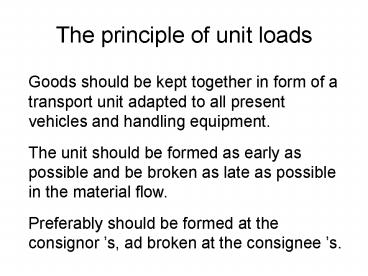The principle of unit loads - PowerPoint PPT Presentation
1 / 15
Title:
The principle of unit loads
Description:
The principle of unit loads. Goods should be kept together in ... Semi-trailer. Roll-on frame. The module of 600x400 mm. The modular design of the pallet system ... – PowerPoint PPT presentation
Number of Views:180
Avg rating:3.0/5.0
Title: The principle of unit loads
1
The principle of unit loads
Goods should be kept together in form of a
transport unit adapted to all present vehicles
and handling equipment. The unit should be formed
as early as possible and be broken as late as
possible in the material flow. Preferably should
be formed at the consignor s, ad broken at the
consignee s.
2
Unit loads
- Unit loads are parts of a shipment that can be
treated as a single unit during cargo handling
and transportation. - The size or dimensions of the unit load can vary
according to requirements and to the means of
transport and packaging container available. - To optimize the cargo handling, transport and
storage processes, standardization of unit loads
is desirable. - The most common unit loads are pallets and
components with bases that resemble pallets, such
as pallet, etc. - The most important properties of a unit load are
that it can be loaded to ensure a tight fit, its
modularity and its stability, the last of which
ensures that it can be stowed safely and will not
be damaged by load securing measures.
3
Characteristics of an unit load
- Large as possible
- Formed as early as possible
- Broken as late as possible
- Be stable and rough
- Be able to be handled by all equipment in the
transport chain
4
Benefits of using unit loads
- Simpler, faster and cheaper trans-shipments
between transport modes - Reduced terminal times for vehicles leading to
better resource utilisation - Less goods damage and costs for wrapping
- Easier to choose load unit type
- Easier document handling
5
Costs of using unit loads
- Need for technical adaptation
- Need for larger and more costly transhipment
equipment - Economies of scale cause less flexibility
- Extra costs for unit loads and empty positioning
6
Recommended maximum weights for manual handling
7
Handling costs with differenthandling methods
8
Attività della movimentazione
9
Full loads, part loads, general cargo and parcels
simple operations low entry barrier more
difficult operations often with general
cargo consolidation in terminals requires a
network large economies of scale speed is
essential
10
Unit loads
Container Container capacities are stated in
terms of twenty-foot equivalent unit (TEU). Swap
body Semi-trailer Roll-on frame
11
The module of 600x400 mm
12
The modular design of the pallet system
13
Moving floor to allow external sequence loading
(Moving deck)
14
Container variants
15
ISOcontainer































